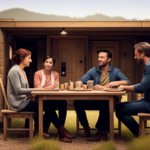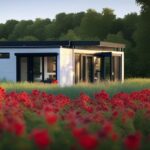Beginners Guides
How To Purchase A Tiny House
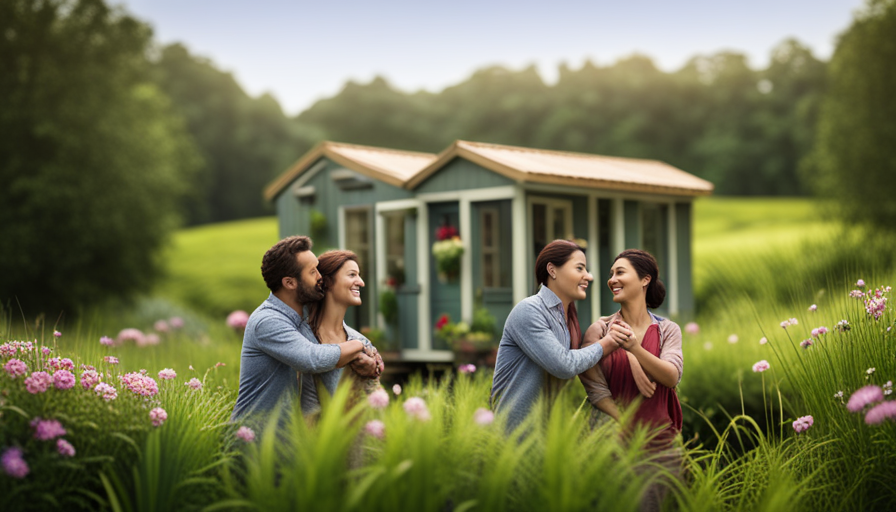
Buying a tiny house is akin to choosing the simplicity and intentionality of living in a snug cottage nestled in the forest. Picture scaling down your possessions and moving into an area that’s not just practical, but also brimming with charisma and personality.
In this article, I will guide you through the process of purchasing a tiny house, from determining your needs and budget to enjoying the benefits of tiny house living. We will explore different types of tiny houses, find the right location, research and visit builders, and consider financing options.
Additionally, I will share tips on customizing and designing your tiny house, preparing for the move-in process, and adjusting to tiny house living.
So, if you’re ready to embark on a journey towards minimalism and embracing a smaller footprint, let’s dive in and discover the world of tiny house living together.
Key Takeaways
- Determine your needs, budget, and personal preferences before purchasing a tiny house.
- Research different types of tiny houses and find the perfect fit for your lifestyle.
- Understand the additional expenses involved in owning a tiny house, such as land, utilities, and maintenance.
- Explore financing options, including personal loans, financing programs for tiny houses, or alternative funding sources like crowdfunding.
Determine Your Needs and Budget
Figuring out your needs and budget is crucial when it comes to buying a tiny house. It’s important to consider your personal preferences and lifestyle to determine what features and amenities are essential for you.
Think about the number of rooms you need, the size of the living space, and any specific requirements such as a kitchen or bathroom. This will help you narrow down your options and find a tiny house that suits your needs perfectly.
Alongside personal preferences, financial planning is a key factor in purchasing a tiny house. Start by evaluating your budget and determining how much you can comfortably afford to spend. Consider not only the cost of the tiny house itself but also additional expenses such as land, utilities, and maintenance. It’s crucial to have a clear understanding of your financial situation to avoid any financial strain in the future.
Once you have a clear picture of your needs and budget, it’s time to research different types of tiny houses. This will allow you to explore various designs, layouts, and styles that may align with your preferences. It’s essential to gather as much information as possible and compare the pros and cons of each option. By doing so, you’ll be well-prepared to make an informed decision on the perfect tiny house for you.
Research Different Types of Tiny Houses
Exploring the vast array of diminutive dwellings opens a world of possibilities for those seeking a unique and compact abode. When researching different types of tiny houses, it’s important to consider the various styles available and their pros and cons.
Here are five types of tiny houses to consider:
-
Traditional Tiny House: This style offers a cozy and rustic feel, with a focus on maximizing space efficiency. It’s perfect for those who enjoy a simpler lifestyle and don’t mind limited storage options.
-
Modern Tiny House: With sleek lines and contemporary design, this style emphasizes minimalism and clean aesthetics. It’s ideal for individuals who crave a more modern and stylish living environment.
-
Tiny House on Wheels: This portable option allows for flexibility and the ability to change locations. It’s a great choice for those who desire both mobility and the freedom to live in different places.
-
Tiny House with Loft: This design utilizes vertical space effectively, providing extra storage or an additional sleeping area. It’s suitable for individuals who need more room but still want to maintain a small footprint.
-
Tiny House Community: Living in a tiny house community offers a sense of community and shared resources. It’s perfect for those who value social connections and want to embrace a more sustainable lifestyle.
Researching different types of tiny houses will help you determine which style best suits your needs and preferences. Once you’ve chosen the right type of tiny house, the next step is to find the right location for your new compact abode.
Find the Right Location
When it comes to finding the perfect spot, you’ll discover a world of enchanting locations that will make your heart skip a beat.
Finding a suitable location for your tiny house is crucial, as it will determine your overall experience and satisfaction. The first step is to research different areas and consider your personal preferences. Do you prefer a bustling city, a peaceful countryside, or a charming coastal town?
Once you have narrowed down your options, it’s important to understand the zoning regulations for tiny houses in each location. Some areas have specific rules and restrictions when it comes to parking and living in a tiny house. Make sure to check with local authorities and obtain any necessary permits before making a final decision.
Additionally, consider factors such as proximity to amenities, access to utilities, and the overall community vibe. By finding the right location, you can create a harmonious living environment that suits your lifestyle and preferences.
Now that you have identified potential locations, it’s time to research and visit tiny house builders who can help bring your dream home to life.
Research and Visit Tiny House Builders
To find the right builder for your dream home, start by researching and visiting different companies that specialize in creating custom tiny homes. This will allow you to see their craftsmanship up close and ask any questions you may have.
Did you know that according to a recent survey, 75% of tiny house owners reported being highly satisfied with their builder’s workmanship and design? This is why it’s crucial to spend time researching and visiting different builders to ensure you find one that aligns with your vision and expectations.
One important aspect to consider during your research is reading tiny house builder reviews. These reviews provide valuable insights into the experiences of past customers and can give you a sense of the builder’s reputation and quality of work. Look for builders that consistently receive positive feedback and have a track record of delivering on their promises.
In addition to reading reviews, visiting model homes is another great way to get a feel for a builder’s style and quality. Many builders have model homes that you can tour, allowing you to see firsthand the level of craftsmanship and attention to detail they put into their work. Take note of the materials used, the layout, and any unique features that stand out to you.
By thoroughly researching and visiting different builders, you can make an informed decision and find the right builder for your tiny house. Once you have found a builder that meets your needs, you can then consider financing options for your new home.
Consider Financing Options
When considering financing options for purchasing a tiny house, there are several key points to keep in mind.
First, personal savings and budgeting can play a significant role in affording a tiny house. It’s important to carefully assess your financial situation and determine how much you can comfortably save and budget for this investment.
Second, loans and financing programs are another option to explore. Banks and credit unions may offer specialized loans for tiny house purchases, and it’s worth researching and comparing different interest rates and terms.
Lastly, crowdfunding and alternative funding sources can be viable options for those looking for creative ways to finance their tiny house. Platforms like Kickstarter or GoFundMe can help you raise the necessary funds, while exploring alternative funding sources such as grants or sponsorships can also be fruitful.
Personal Savings and Budgeting
Saving and budgeting can be key factors in realizing the dream of owning a tiny house. When it comes to personal finance, it’s important to have a clear strategy in place. Here are four essential tips to help you save and budget effectively for your tiny house:
-
Set a goal: Determine how much you need to save for your tiny house and set a realistic timeline for achieving it.
-
Create a budget: Track your income and expenses to identify areas where you can cut back and allocate more towards your savings.
-
Cut unnecessary expenses: Evaluate your spending habits and consider reducing discretionary expenses like eating out or buying luxury items.
-
Explore investment strategies: Consider investing a portion of your savings in low-risk options that can potentially grow over time.
By implementing these strategies, you can build up your personal savings and create a solid foundation for purchasing a tiny house.
As we move on to the next section about loans and financing programs, it’s important to explore all available options to make your dream a reality.
Loans and Financing Programs
Looking for ways to fund your dream of owning a cozy home on wheels? Explore the various loans and financing programs available to make it a reality!
When it comes to purchasing a tiny house, there are several loans and financing options to consider. One common option is a personal loan, which can be obtained from a bank or credit union. These loans typically have fixed interest rates and terms, making it easier to budget for monthly payments.
Another option is to explore financing programs specifically designed for tiny houses. These programs often have specialized terms and requirements tailored to the unique aspects of tiny house ownership.
When comparing interest rates and terms, it’s important to consider the overall cost of the loan and the monthly payment amount. By carefully evaluating your options, you can find the financing solution that best suits your needs and budget.
Now let’s explore crowdfunding and alternative funding sources to continue our journey towards owning a tiny house.
Crowdfunding and Alternative Funding Sources
If you’re considering alternative funding sources for your dream of owning a cozy mobile home, crowdfunding might be the solution for you, with over 50% of tiny house projects successfully funded through platforms like Kickstarter and Indiegogo. These crowdfunding platforms provide a unique opportunity for individuals to raise funds for their tiny house projects by showcasing their idea and offering rewards to backers. Here is a table that compares some popular crowdfunding platforms and their features:
| Crowdfunding Platform | Success Rate | Fees | Project Duration | Backer Rewards |
|---|---|---|---|---|
| Kickstarter | 36% | 5% | 30-60 days | Varied |
| Indiegogo | 9% | 5% | Flexible | Varied |
| GoFundMe | N/A | 0% | Flexible | Varied |
| Patreon | N/A | 5-12% | Ongoing | Membership |
| SeedInvest | N/A | Varies | Varies | Equity |
Crowdfunding not only provides a means to financially support your tiny house project, but it also allows you to engage with a community of like-minded individuals who share your passion for alternative living. Transitioning into the subsequent section about planning for utilities and amenities, it’s important to consider how you will power and maintain your tiny house.
Plan for Utilities and Amenities
When planning for utilities and amenities in my tiny house, there are a few key points to consider.
First, I need to think about electricity and water supply. I’ll need to research and choose the most efficient and sustainable options for my needs.
Second, I need to decide on the heating and cooling systems that’ll keep my tiny house comfortable year-round. I’ll need to explore options such as solar panels, propane heaters, and efficient insulation.
Finally, I need to plan for waste management, including the use of composting toilets. They can help minimize water usage and provide nutrient-rich soil for gardening.
Overall, careful planning and consideration of these factors will ensure that my tiny house isn’t only functional but also sustainable and eco-friendly.
Electricity and Water Supply
To ensure a reliable electricity and water supply, you’ll need to carefully consider the infrastructure available in the location where you plan to place your tiny house. Start by researching the electricity options in the area. Determine if there are power lines nearby that can be easily connected to your tiny house. Alternatively, you may need to explore off-grid solutions such as solar panels or wind turbines.
Regarding water sources, find out if there is a municipal water supply that can be tapped into. If not, you might need to dig a well or consider rainwater harvesting systems. It’s important to understand the local regulations and obtain any necessary permits for these installations.
Transitioning into the subsequent section about heating and cooling systems, it’s crucial to consider the climate and insulation of your tiny house.
Heating and Cooling Systems
When it comes to living in a tiny house, it’s important to consider the heating and cooling systems that will keep you comfortable year-round. In such a small space, efficiency is key. That’s why many tiny house owners opt for smart thermostats and energy-efficient appliances to regulate the temperature and minimize energy consumption. These smart thermostats allow you to control the temperature remotely, ensuring that you arrive to a cozy home after a long day. Additionally, energy-efficient appliances such as mini-split air conditioners and compact heaters are perfect for heating and cooling tiny spaces without wasting energy. By investing in these systems, you can enjoy a comfortable living environment while minimizing your carbon footprint. Now let’s move on to the next important aspect of living in a tiny house: waste management and composting toilets.
Waste Management and Composting Toilets
One way to create a sustainable and eco-friendly living environment in a small home is by implementing waste management strategies, including the use of composting toilets. Composting toilets are a great alternative to traditional flush toilets as they help reduce water usage and provide a natural way to dispose of human waste.
Here are three key benefits of using composting toilets for waste management in your tiny house:
-
Environmental friendliness: Composting toilets promote eco-friendly living by minimizing the use of water and reducing the carbon footprint associated with sewage treatment plants.
-
Nutrient-rich compost: The waste produced in composting toilets can be transformed into nutrient-rich compost, which can be used to fertilize your garden or plants.
-
Cost-effective: Composting toilets eliminate the need for expensive plumbing systems and reduce water bills, making them a cost-effective solution for waste management.
Implementing waste management strategies like composting toilets in your tiny house can contribute to a more sustainable and eco-friendly lifestyle.
Now, let’s dive into the next section about customizing and designing your tiny house.
Customize and Design Your Tiny House
When it comes to customizing and designing your tiny house, there are several key points to consider.
First, space-saving furniture and storage solutions are crucial in maximizing the limited space available. From foldable tables and multifunctional seating to hidden storage compartments, these innovative solutions can help make the most of every inch.
Additionally, interior design and décor ideas can add personality and style to your tiny house. Whether it’s through clever color schemes, creative lighting, or unique wall decorations, these elements can make your tiny house feel like home.
Lastly, incorporating sustainable and eco-friendly features in your tiny house can not only reduce your environmental impact but also enhance the overall comfort and efficiency of your living space. From solar panels and rainwater collection systems to energy-efficient appliances and natural building materials, there are endless possibilities to create a sustainable and eco-friendly tiny house.
Space-Saving Furniture and Storage Solutions
To maximize the minuscule living space of your tiny house, you’ll need to get creative with space-saving furniture and storage solutions – because let’s face it, your shoebox-sized home won’t magically expand on its own!
Here are three essential items to consider for optimizing your space:
-
Multi-functional furniture: Invest in pieces that serve multiple purposes, such as a sofa that can transform into a bed or a dining table that doubles as a desk. This way, you can make the most of every square inch.
-
Vertical storage units: Utilize the height of your tiny house by installing shelves, cabinets, and hooks that go up the walls. This will free up valuable floor space and keep your belongings organized.
-
Underneath storage: Make use of the often overlooked area beneath your furniture. Choose beds, sofas, and tables that have built-in storage compartments to hide away items you don’t frequently use.
By incorporating these space-saving furniture and storage solutions, you’ll be able to create a functional and efficient living space.
In the next section, we’ll explore interior design and décor ideas to make your tiny house feel like a cozy home.
Interior Design and Décor Ideas
Enhance the ambiance of your compact living space with creative interior design and décor ideas that will transform your tiny house into a warm and inviting sanctuary. When it comes to designing the interior of your tiny house, it’s important to maximize the use of space while still maintaining a stylish and cozy atmosphere. One key tip is to choose a color scheme that is light and neutral, as this will make your space appear larger and more open. Another idea is to utilize multi-functional furniture, such as a sofa that can also be a bed or a storage ottoman that doubles as a coffee table. Additionally, incorporating vertical storage solutions, such as wall-mounted shelves and hanging organizers, can help you make the most of your limited space. By implementing these interior design tips and color scheme ideas, you can create a visually appealing and functional living area within your tiny house. As we move on to the next section about incorporating sustainable and eco-friendly features, it’s important to consider the environmental impact of your design choices.
Incorporating Sustainable and Eco-Friendly Features
Transform your compact living space into an eco-friendly oasis by incorporating sustainable features that won’t only benefit the environment but will also enhance your overall living experience. Here are some ideas to get you started:
-
Choose eco-friendly materials for your tiny house, such as reclaimed wood or bamboo flooring, recycled glass countertops, and low-VOC paints.
-
Install energy-efficient appliances, like a compact dishwasher and refrigerator, LED lighting, and a tankless water heater.
-
Maximize natural light by adding skylights or large windows, reducing the need for artificial lighting during the day.
-
Opt for a composting toilet system to minimize water usage and generate nutrient-rich soil for your garden.
By incorporating these sustainable features, you can create an environmentally friendly living space that’s both stylish and functional.
As you prepare for the move-in process, consider how these features will make your tiny house a greener and more efficient home.
Prepare for the Move-In Process
When it comes to preparing for the move-in process of your tiny house, there are several key points to keep in mind.
First, you’ll need to tackle the task of packing and downsizing your belongings to fit within the limited space of your tiny house.
Next, you’ll need to decide whether to hire professional movers or opt for a DIY moving approach.
Finally, you’ll need to ensure that you set up utilities and register your new address to make your tiny house fully functional and legally recognized.
Packing and Downsizing
To make the tiny house experience even more amusing, it’s time to shrink your belongings and bid farewell to unnecessary clutter. Packing and downsizing can be a daunting task, but with a few tips and strategies, it can become an exciting opportunity for a fresh start.
Here are some ideas to help you get started:
-
Prioritize: Begin by sorting your belongings into three categories: keep, donate/sell, and discard. This will help you make decisions easier and eliminate unnecessary items.
-
Maximize Space: Utilize smart storage solutions such as collapsible furniture, hanging organizers, and under-bed storage to make the most out of limited space.
-
Digitize: Scan important documents and photos to reduce paper clutter and save space. Store them securely in the cloud or on a hard drive.
-
Multifunctional Items: Invest in furniture and decor that serves multiple purposes, such as a sofa with hidden storage or a coffee table that can be converted into a dining table.
By following these packing tips and downsizing strategies, you’ll be well on your way to a clutter-free tiny house.
Next, let’s explore the options of hiring professional movers or DIY moving to simplify the transition even further.
Hiring Professional Movers or DIY Moving
Now that we’ve discussed the process of packing and downsizing when purchasing a tiny house, it’s important to consider how you will physically move your belongings to your new home.
One option is to hire professional movers who specialize in handling small spaces. Not only will they have experience navigating tight corners and small doorways, but they’ll also ensure that your belongings are safely transported to your new location.
However, it’s important to consider the cost comparison between hiring professional movers and doing the move yourself. While hiring professionals may save you time and effort, it can also be a significant expense.
On the other hand, opting for a DIY move may require more physical labor but can be a cost-effective option.
Once you’ve decided on the best moving method for you, the next step is to set up utilities and register your address.
Setting Up Utilities and Registering Your Address
After deciding on the best method for moving, you can begin the process of setting up utilities and registering your new address.
The first step is to contact the local utility companies to establish water, electricity, and gas services for your tiny house. Provide them with your new address and any necessary documentation they may require. It’s important to schedule these installations in advance to ensure that your utilities are up and running before you move in.
Additionally, you will need to register your new address with the post office, as well as update your address with any relevant institutions such as banks, insurance companies, and government agencies.
Once you have completed these tasks, you can start adjusting to tiny house living by organizing your space and familiarizing yourself with the unique features of your new home.
Adjusting to Tiny House Living
Living in a tiny house will completely revolutionize your concept of space and force you to simplify your life beyond your wildest imagination. Adjusting to tiny house living comes with its own set of challenges, but with some creativity and a willingness to maximize space, you can create a comfortable and functional living environment. Here are some tips to help you make the most of your tiny house:
Firstly, think vertically. Utilize wall space for storage by installing shelves, hooks, and hanging baskets. This allows you to keep your belongings organized and easily accessible without cluttering the limited floor space. Additionally, consider multi-purpose furniture such as a sofa that can be converted into a bed, or a dining table that can double as a work desk.
Secondly, embrace minimalism. Living in a tiny house requires you to prioritize your belongings and only keep what you truly need. Take the time to declutter and let go of unnecessary items. This not only frees up space but also brings a sense of calm and simplicity to your living environment.
Lastly, create outdoor living spaces. While the interior of a tiny house may be compact, you can extend your living area to the outdoors. Set up a cozy patio or deck where you can relax, entertain guests, and enjoy the natural surroundings.
By adjusting to the challenges and maximizing space in your tiny house, you can create a comfortable and efficient living space that suits your needs. Transitioning into the subsequent section about ‘enjoying the benefits of tiny house living,’ you’ll discover the many advantages that come with simplifying your life in a tiny house.
Enjoying the Benefits of Tiny House Living
To fully embrace the freedom of a minimalist lifestyle, you’ll discover a world of possibilities and endless adventures awaiting you within the cozy confines of your tiny sanctuary.
Living in a tiny house comes with numerous benefits that go beyond just saving money and reducing your carbon footprint. Here are four reasons why you’ll love the benefits of minimalism and living off the grid:
-
Financial Freedom: By downsizing your living space, you can significantly reduce your expenses. With lower utility bills, minimal maintenance costs, and no mortgage, you’ll have more money to pursue your passions and enjoy life to the fullest.
-
Environmental Sustainability: Tiny houses are designed to be eco-friendly, using less energy and producing less waste. Living off the grid allows you to harness renewable energy sources like solar power, reducing your reliance on fossil fuels and minimizing your impact on the environment.
-
Simplified Living: Living in a tiny house forces you to declutter and prioritize what truly matters. You’ll find yourself surrounded only by the things you need and love, leading to a more organized and stress-free life.
-
Flexibility and Mobility: Tiny houses are portable, giving you the freedom to travel and explore new places without sacrificing the comforts of home. Whether you want to move to a different city or embark on a cross-country adventure, your tiny house can go wherever you go.
Embracing minimalism and living off the grid in a tiny house opens up a whole new world of possibilities, allowing you to live a simpler, more fulfilling life.
Frequently Asked Questions
What are the legal requirements for owning and living in a tiny house?
Living in a tiny house is like embarking on a whimsical journey through a miniature world. However, before setting off, it’s crucial to understand the legal requirements.
To ensure compliance, familiarize yourself with building codes. These regulations vary depending on your location, so research your local zoning laws and permits.
Don’t forget to consult professionals who specialize in tiny house construction for guidance on meeting all legal obligations.
Remember, a dreamy tiny house can become a reality if you navigate the legal landscape with care.
How do I find land or a community that allows tiny houses?
To find land or a community that permits tiny houses, start by researching local zoning regulations and building codes. Look for areas that have relaxed restrictions or specific zoning for tiny houses.
Online directories and forums dedicated to tiny house living can also help you connect with communities or individuals who are open to hosting tiny houses.
As for financing options, consider exploring personal loans, RV loans, or crowdfunding platforms that cater to tiny house ownership.
Are there any zoning restrictions or regulations I need to be aware of?
Yes, there are zoning restrictions and regulations that you need to be aware of when considering a tiny house. Zoning restrictions vary depending on the location, so it’s important to research the specific area you plan to live in.
Some areas have minimum square footage requirements or restrictions on where tiny houses can be placed. Additionally, you’ll need to comply with building codes to ensure the safety and structural integrity of your tiny house.
What are the maintenance costs associated with owning a tiny house?
Maintaining a tiny house is like tending to a delicate bonsai tree; it requires constant attention and care.
Tiny house maintenance costs can vary depending on factors like location, materials used, and personal preferences.
To keep costs low, I recommend regular inspections for any leaks or damages, cleaning the gutters, and keeping the exterior well-maintained.
Additionally, proper insulation, regular HVAC maintenance, and routine pest control can help ensure your tiny house remains in good condition for years to come.
Can I still qualify for a mortgage or home insurance for a tiny house?
Yes, it’s possible to qualify for a mortgage and obtain home insurance coverage for a tiny house. Mortgage qualification for a tiny house is similar to that of a traditional home, although some lenders may have specific requirements.
As for home insurance, there are insurance providers who offer coverage specifically designed for tiny houses. It’s important to research and compare options to find the best mortgage and insurance options that suit your needs and circumstances.
Conclusion
After going through the process of purchasing a tiny house, I can confidently say that it’s been a life-changing experience. The juxtaposition of downsizing my belongings while expanding my sense of freedom and simplicity has evoked a profound sense of joy and fulfillment.
Living in a tiny house has allowed me to prioritize what truly matters and embrace a more sustainable and minimalist lifestyle. The benefits of tiny house living are immeasurable, and I encourage anyone seeking a change to embark on this incredible journey.
Hi, I’m Emma. I’m the Editor in Chief of Tiny House 43, a blog all about tiny houses. While tree houses are often associated with childhood, they can be the perfect adult retreat. They offer a cozy space to relax and unwind, surrounded by nature. And since they’re typically built on stilts or raised platforms, they offer stunning views that traditional homes simply can’t match. If you’re looking for a unique and romantic getaway, a tree house tiny house might just be the perfect option.
Beginners Guides
How Do I Finance a Tiny House

I have always desired to own a small, comfortable home, but typical financing solutions appeared unattainable. That’s when I found out about the concept of tiny houses. These efficient, eco-friendly residences provide a budget-friendly option to conventional homes.
But how do I finance a tiny house? In this article, I’ll guide you through the various financing options and share practical tips for saving and budgeting. Whether you’re a minimalist enthusiast or simply looking to downsize, this article is here to help you make your tiny house dreams a reality.
Key Takeaways
- Financing options for tiny houses include personal loans, RV loans, and crowdfunding platforms.
- Traditional financing options such as bank loans and personal loans from banks or online lenders are available for tiny house financing.
- Alternative financing options like crowdfunding and personal loans can be explored, but they have their own pros and cons.
- Saving and budgeting for a tiny house is important, and options like obtaining a loan specifically designed for tiny house financing or exploring crowdfunding platforms can be considered.
Understanding the Cost of a Tiny House
I can’t believe how much it costs to build a tiny house. Understanding the financing process and the factors affecting the cost of a tiny house is crucial before embarking on this journey.
Firstly, let’s talk about the financing process. Many people choose to finance their tiny houses through personal loans, RV loans, or even crowdfunding platforms. It’s important to research and compare interest rates and terms to find the best option for your financial situation.
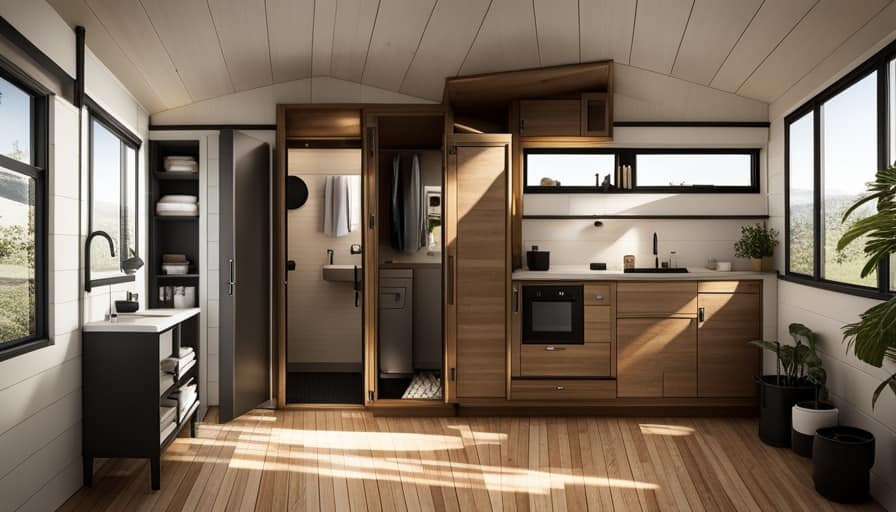
Now, let’s discuss the factors that affect the cost of a tiny house. Size, materials, and customization are the main factors. The larger the size, the more materials and labor will be required, thus increasing the cost. Additionally, using high-quality and sustainable materials can also raise the price. Lastly, customization, such as unique designs or added features, will add to the overall cost.
Exploring Traditional Financing Options
When exploring financing options for a tiny house, it’s important to consider traditional routes such as bank loans or credit unions. These options can provide the necessary funds to purchase or build your dream tiny house. Here are some key points to keep in mind when considering traditional financing options:
-
Traditional bank loans: Many banks offer loans specifically designed for home construction or purchases, which can be used for a tiny house.
-
Personal loans: If you don’t qualify for a traditional bank loan, personal loans from banks or online lenders can be a viable alternative.
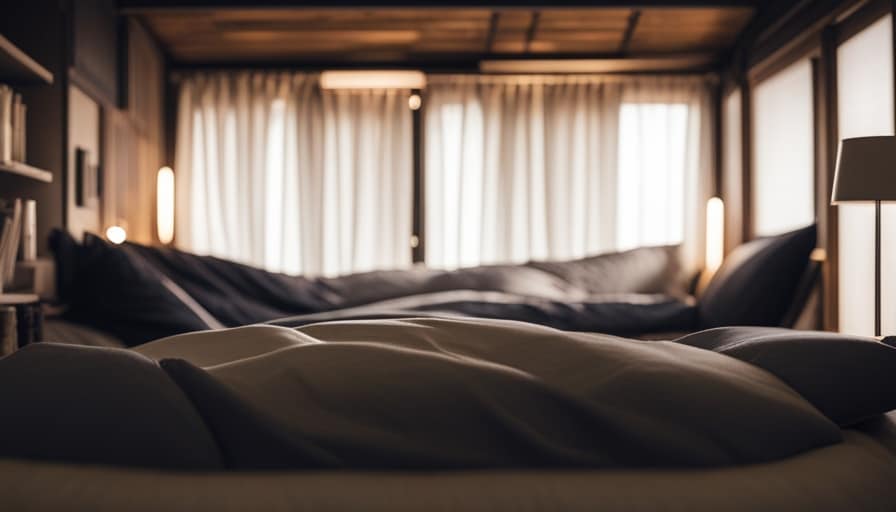
-
Interest rates: Traditional financing options may offer competitive interest rates, depending on your creditworthiness and other factors.
-
Repayment terms: It’s important to carefully review the repayment terms of any loan you consider, including the length of the loan and monthly payment amounts.
-
Eligibility requirements: Different lenders have different eligibility criteria, so it’s important to research and compare options to find the best fit for your needs.
Exploring traditional financing options can provide a solid foundation for financing your tiny house.
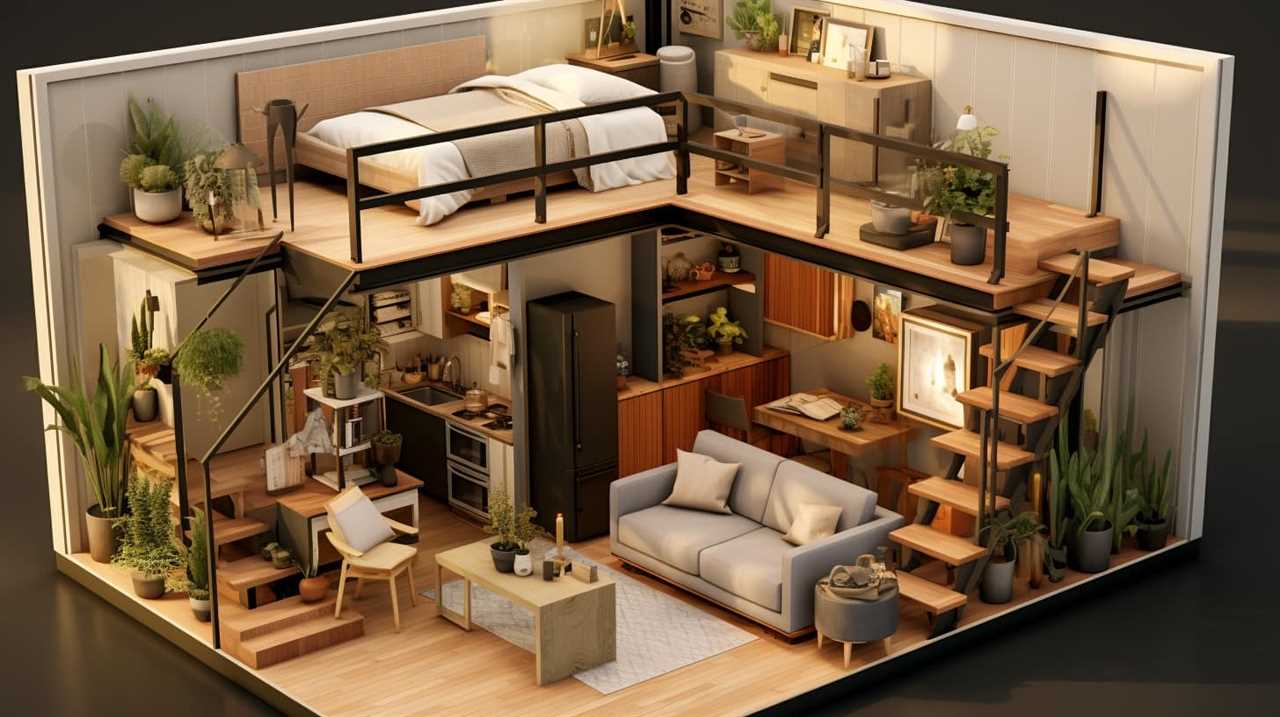
However, there are also alternative financing options worth considering, which will be explored in the next section.
Exploring Alternative Financing Options
One option to consider when exploring alternative financing options for a tiny house is crowdfunding. Crowdfunding is a method of raising funds by pooling small amounts of money from a large number of people. It can be a viable option for financing a tiny house as it allows individuals to contribute towards the project. Another alternative financing option is personal loans. Personal loans are loans that are not secured by any collateral, such as a house or car. They can be used to finance a variety of expenses, including the construction or purchase of a tiny house. When considering personal loans, it is important to shop around for the best interest rates and terms. Below is a table comparing crowdfunding and personal loans as alternative financing options for a tiny house:
| Financing Option | Pros | Cons |
|---|---|---|
| Crowdfunding | – Can raise funds from others | – No guarantee of reaching goal |
| Personal Loans | – Can be used for any purpose | – May require good credit score |
Both crowdfunding and personal loans can provide alternative financing options for a tiny house. It is important to carefully consider the pros and cons of each option before making a decision.
Tips for Saving and Budgeting for a Tiny House
Saving and budgeting for a tiny house involves prioritizing expenses and finding ways to cut costs. Here are some practical tips to help you save and budget effectively:

- Create a detailed budget: Start by listing all your expenses and income to determine how much you can allocate towards your tiny house.
- Cut unnecessary expenses: Identify areas where you can reduce spending, such as eating out less or canceling unused subscriptions.
- Save consistently: Set aside a certain amount of money each month specifically for your tiny house fund.
- Consider a tiny house loan: Research options for obtaining a loan specifically designed for tiny house financing.
- Explore crowdfunding options: Crowdfunding platforms can help you raise funds for your tiny house project by reaching out to a wider network of supporters.
By implementing these tips, you can make steady progress towards your goal of owning a tiny house.
Now, let’s explore some resources for grants and financial assistance to further support your journey.
Resources for Grants and Financial Assistance
I can explore various resources for grants and financial assistance to help me finance my tiny house. Grants are a great option to consider, as they provide funding that doesn’t need to be repaid.
There are several organizations and programs that offer grants specifically for individuals looking to build or purchase a tiny house. One such resource is the Tiny House Fund, which provides grants to low-income individuals and families for the construction of tiny houses.
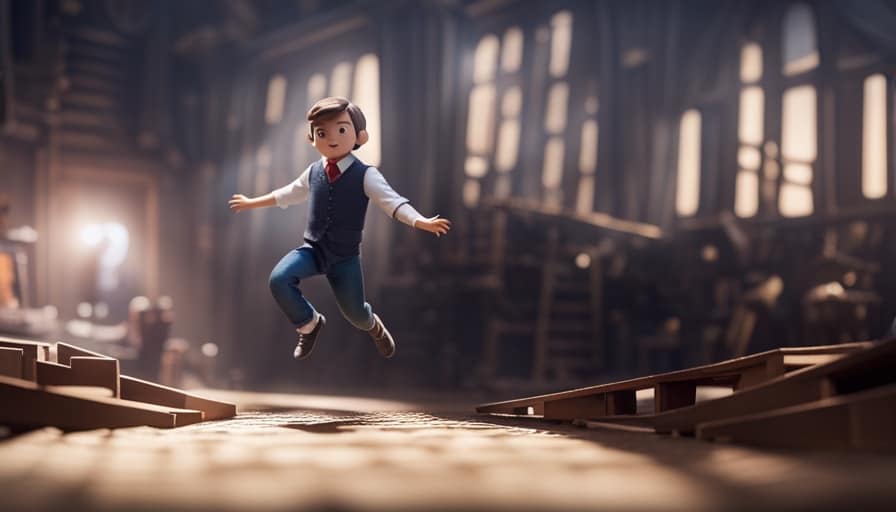
Another option is the Housing Assistance Council, which offers grants to organizations that provide housing assistance to low-income individuals.
It’s important to note that grants availability may vary depending on location and eligibility criteria. Therefore, it’s crucial to research and identify grants that align with your specific needs and circumstances.
Frequently Asked Questions
Can I Use a Personal Loan to Finance a Tiny House?
Yes, you can use a personal loan to finance a tiny house. It’s one of the alternative financing options available. However, make sure to research interest rates and terms to find the best option for you.
Are There Any Specific Qualifications I Need to Meet in Order to Obtain a Traditional Mortgage for a Tiny House?
To obtain a traditional mortgage for a tiny house, you need to meet certain qualifying criteria. The application process requires providing necessary documentation, such as income verification and credit history.
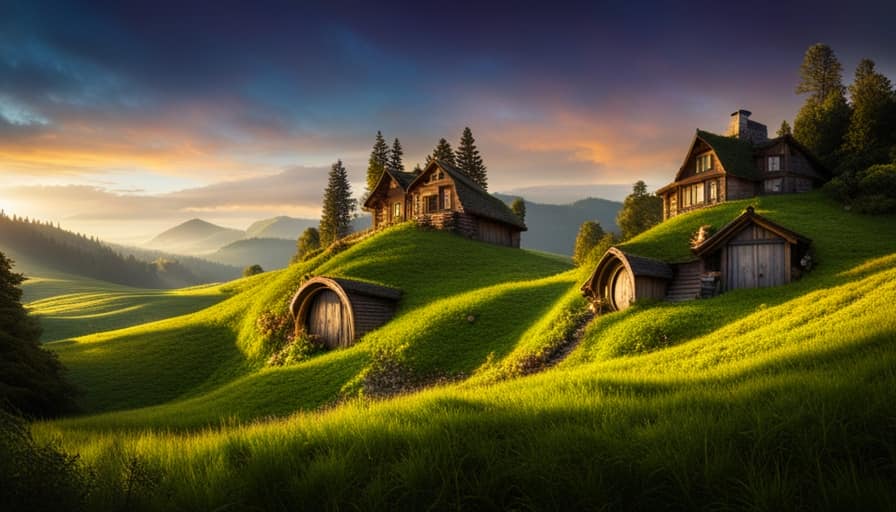
Are There Any Tax Benefits or Incentives Available for Financing a Tiny House?
Tax benefits and incentives can be available when financing a tiny house. It’s important to research and consult with a tax professional to understand the specific benefits that may apply to your situation.
What Are the Advantages and Disadvantages of Using Alternative Financing Options for a Tiny House?
Using alternative financing options for a tiny house has advantages, such as flexibility and lower interest rates, but also disadvantages, like stricter eligibility criteria. It’s important to weigh the pros and cons before deciding.
Are There Any Specific Tips or Strategies for Saving and Budgeting for a Tiny House That Differ From Traditional Homeownership?
When it comes to saving and budgeting for a tiny house, there are some specific tips and strategies that differ from traditional homeownership. Some budgeting strategies include cutting expenses, tracking spending, and setting realistic goals. Additionally, saving techniques like automating savings and finding ways to earn extra income can help you reach your financial goals faster.
Conclusion
In conclusion, financing a tiny house may seem daunting, but with careful planning and research, it can be achievable.

By understanding the costs involved, exploring traditional and alternative financing options, and implementing smart saving and budgeting strategies, you can make your dream of owning a tiny house a reality.
Remember, there are also resources available such as grants and financial assistance programs that can provide additional support.
So don’t let financial barriers hold you back, start exploring your options today and embark on your tiny house journey.
I’m Theodore, and I love tiny houses. In fact, I’m the author of Tiny House 43, a book about tiny houses that are also tree houses. I think they’re magical places where imaginations can run wild and adventures are just waiting to happen.
While tree houses are often associated with childhood, they can be the perfect adult retreat. They offer a cozy space to relax and unwind, surrounded by nature. And since they’re typically built on stilts or raised platforms, they offer stunning views that traditional homes simply can’t match.
If you’re looking for a unique and romantic getaway, a tree house tiny house might just be the perfect option.
Beginners Guides
How Do I Draw a Tiny House
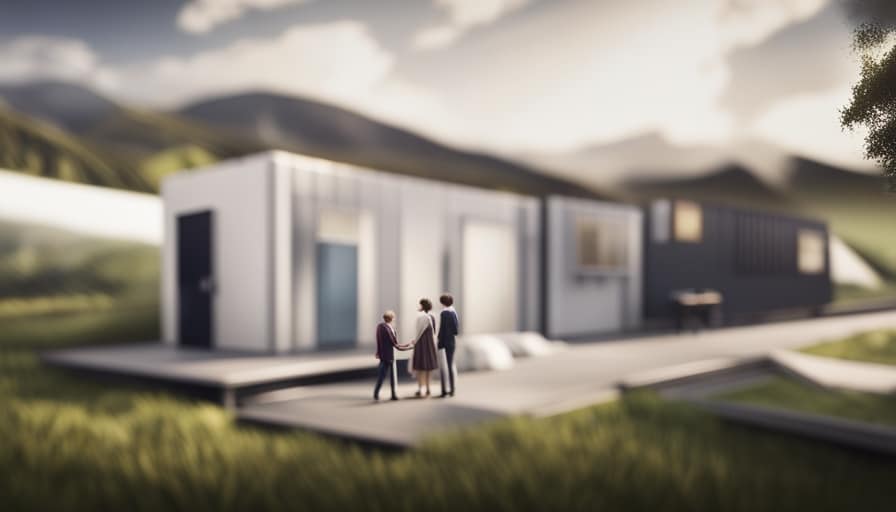
As a future architect, I am constantly captivated by the complexities involved in sketching a small house. It is often said that the beauty lies in the details, and this miniature masterpiece truly exemplifies that sentiment.
In this article, I will guide you through the process of creating a detailed and precise drawing of a tiny house. From understanding the basics of design to adding those finishing touches, you’ll discover how to bring your vision to life on paper.
Let’s dive in and unlock the secrets of drawing a tiny house!
Key Takeaways
- Tiny house design principles prioritize maximizing space in a small footprint and utilizing multi-functional spaces.
- Accurate measurements and choosing the appropriate scale are crucial for a precise and realistic representation.
- Sketching out the layout and floor plan should consider unique storage solutions, placement of windows for natural light, and attention to detail and proportions.
- Adding detail to tiny house elevations can be done by selecting the perfect color palette, incorporating unique architectural elements, and considering light, neutral tones or bold, vibrant colors.
Understanding the Basics of Tiny House Design
As I begin to draw a tiny house, I must first understand the basics of its design. Tiny house design principles are centered around maximizing space in a small footprint. When designing a tiny house, it’s crucial to carefully consider every inch of the layout.

One key principle is to prioritize multi-functional spaces. Each area should serve multiple purposes, such as a living room that can also convert into a bedroom. Storage is another important aspect, with clever solutions like built-in cabinets and hidden compartments. Additionally, utilizing vertical space through lofted areas or tall shelving can help maximize storage and living areas.
Choosing the Right Scale for Your Tiny House Drawing
I should consider the size and dimensions of my tiny house when choosing the right scale for my drawing. Accurate measurements are crucial in creating a precise and realistic representation of my tiny house. By using the correct scale, I can ensure that every element of the design is accurately depicted.
Exploring different design elements for my tiny house scale drawings allows me to experiment with various layouts and configurations. This not only helps me visualize the final result, but also enables me to make informed decisions regarding the placement of furniture, appliances, and other features.
Once I’ve determined the appropriate scale, I can confidently move on to sketching out the layout and floor plan, bringing my tiny house design to life.

Sketching Out the Layout and Floor Plan
Once I’ve chosen the right scale for my tiny house drawing, it’s important to start sketching out the layout and floor plan.
To ensure an efficient use of space, I’ll incorporate unique storage solutions. This can include built-in shelving, hidden compartments, and multi-functional furniture.
Additionally, I’ll carefully consider the placement of windows for optimal natural light. This won’t only enhance the overall ambiance of the tiny house but also reduce the need for artificial lighting during the day.
By strategically positioning windows in areas where sunlight is abundant, I can create a bright and airy atmosphere.

It’s crucial to prioritize both functionality and aesthetics when sketching out the layout and floor plan of a tiny house.
Adding Detail to Your Tiny House Elevations
While adding detail to my tiny house elevations, I’ll focus on incorporating architectural elements that enhance the overall design and character of the house.
One important aspect to consider is selecting the perfect color palette for your tiny house design. The colors you choose can greatly impact the visual appeal and atmosphere of your tiny home. Consider using light, neutral tones to create a spacious and airy feel, or bold and vibrant colors to add a pop of personality.
In addition to color, incorporating unique architectural elements into your tiny house elevation can make it stand out. Whether it’s a charming bay window, a decorative trim, or an interesting roofline, these elements can add visual interest and character to your tiny home.
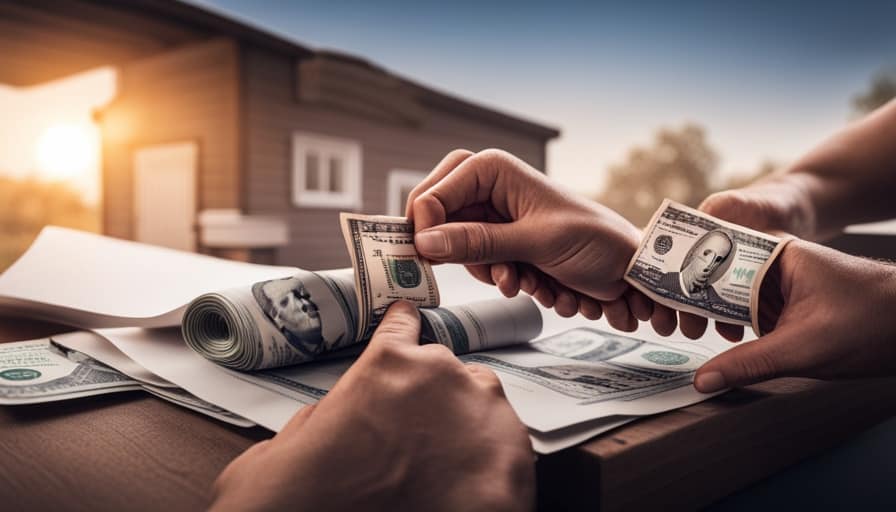
By carefully selecting colors and incorporating unique architectural elements, you can create a tiny house elevation that’s both visually appealing and reflective of your personal style.
Now, let’s move on to finalizing your tiny house drawing with finishing touches.
Finalizing Your Tiny House Drawing With Finishing Touches
Adding decorative details and selecting the right materials are key steps in finalizing your tiny house drawing with finishing touches. To ensure your tiny house design truly stands out, consider the following:
-
Selecting the perfect color palette: Choose colors that reflect your personal style and create an inviting atmosphere. Consider using light and neutral tones to make the space feel larger, or vibrant shades to add a pop of energy.
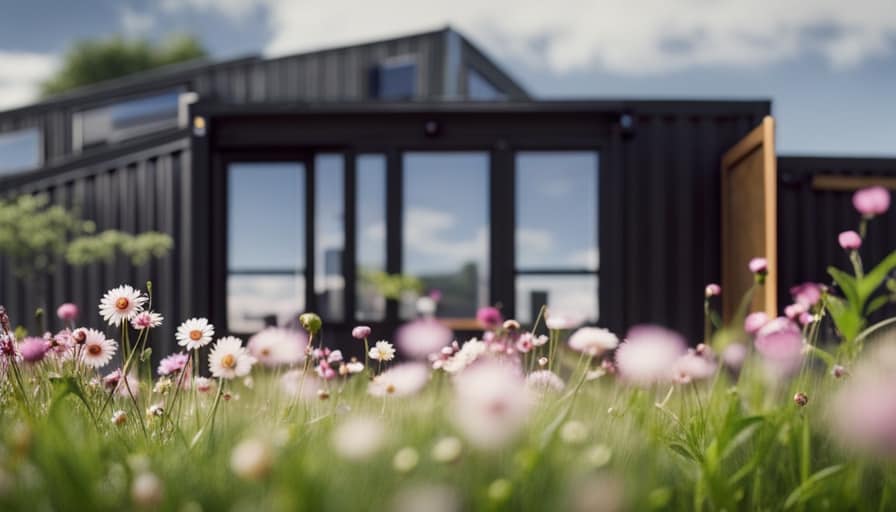
-
Incorporating sustainable and eco-friendly elements: Make your tiny house environmentally friendly by incorporating features such as solar panels, rainwater harvesting systems, and energy-efficient appliances. Use recycled or reclaimed materials whenever possible to reduce waste and minimize your environmental footprint.
-
Adding unique architectural details: Consider incorporating unique architectural elements like exposed beams, arched windows, or a charming front porch to give your tiny house character and charm.
-
Enhancing with landscaping: Don’t forget about the exterior! Enhance your tiny house design with landscaping elements such as flower beds, shrubs, or a small vegetable garden. This will add curb appeal and create a welcoming outdoor space.
Frequently Asked Questions
What Are Some Common Challenges or Obstacles to Consider When Designing a Tiny House?
When designing a tiny house, it is important to consider common challenges and obstacles such as space optimization and design challenges. These factors require precise planning and attention to detail to ensure optimal functionality and livability.
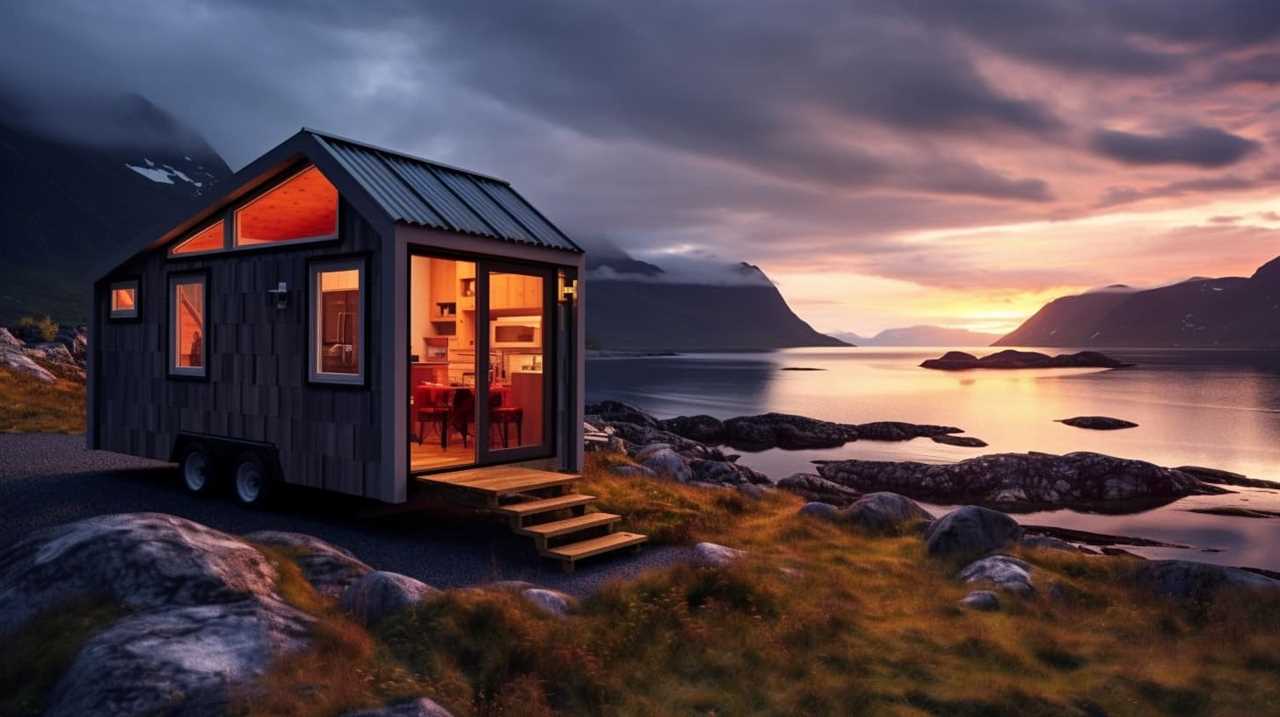
Can I Use Software or Online Tools to Create My Tiny House Drawing?
Yes, you can use software or online tools to create your tiny house drawing. It is best to follow these practices for creating detailed designs: utilize accurate measurements, incorporate necessary features, and ensure proper scaling for a realistic representation.
Are There Any Specific Building Codes or Regulations That I Should Be Aware of When Designing a Tiny House?
When designing a tiny house, it is important to be aware of building code requirements and zoning restrictions. These regulations ensure the safety and legality of your structure, so it’s crucial to familiarize yourself with them before starting your design process.
How Do I Incorporate Sustainable and Eco-Friendly Features Into My Tiny House Design?
To incorporate sustainable and eco-friendly features into my tiny house design, I can use eco-friendly materials like reclaimed wood and recycled insulation. Additionally, I can install energy-efficient systems such as solar panels and a rainwater harvesting system.
Are There Any Recommended Resources or Communities for Further Inspiration and Support in Designing a Tiny House?
There are recommended resources and communities for inspiration and support in tiny house design. Check out tiny house design competitions and online forums for enthusiasts. They provide valuable insights and connections for your project.

Conclusion
In conclusion, drawing a tiny house requires understanding the basics of design, choosing the right scale, and sketching out the layout and floor plan.
By adding detail to the elevations and finalizing the drawing with finishing touches, you can create a precise and detailed representation of your dream tiny home.
Just like a skilled architect carefully crafts a blueprint, your tiny house drawing will serve as the foundation for turning your vision into reality.
I’m Theodore, and I love tiny houses. In fact, I’m the author of Tiny House 43, a book about tiny houses that are also tree houses. I think they’re magical places where imaginations can run wild and adventures are just waiting to happen.
While tree houses are often associated with childhood, they can be the perfect adult retreat. They offer a cozy space to relax and unwind, surrounded by nature. And since they’re typically built on stilts or raised platforms, they offer stunning views that traditional homes simply can’t match.
If you’re looking for a unique and romantic getaway, a tree house tiny house might just be the perfect option.
Beginners Guides
How Do I Find a Tiny House for Sale for Adults

I’m always searching for the ideal tiny home. It feels like finding a needle in a haystack, but with the right approach, it can be done.
In this article, I’ll guide you through the process of finding a tiny house for sale that’s perfect for adults. From exploring online listings to connecting with builders and attending workshops, you’ll discover all the tips and tricks to make your dream of owning a tiny house a reality.
Let’s get started!
Key Takeaways
- The internet offers a wide range of options for finding tiny houses for sale, with online listings providing information on financing options and customization choices.
- Connecting with builders and companies can provide valuable information on purchasing and customizing a tiny house, as well as guidance on building regulations and permits.
- Utilizing social media and online communities can help tap into a network of like-minded individuals, gain recommendations, and access valuable insights and resources from the tiny house community.
- Attending workshops and events can provide education on financing options, networking opportunities, and exposure to the latest trends and designs in the tiny house community.
Exploring Online Listings and Websites
I can start my search for a tiny house by browsing through online listings and websites. The internet offers a vast array of options when it comes to finding a tiny house for sale. Not only can I explore different listings, but I can also learn more about the financing options available for tiny homes.

Many websites provide information on loans, grants, and other financial resources that can help make owning a tiny house a reality. Additionally, these online platforms showcase a variety of tiny house designs and customization options, allowing me to find a home that suits my preferences and needs.
Connecting With Tiny House Builders and Companies
By reaching out to tiny house builders and companies, I can explore my options and gather more information about the process of purchasing and customizing a tiny house. These professionals have extensive knowledge and expertise in building tiny houses and can guide me through the entire process.
When connecting with them, it’s important to inquire about building regulations to ensure that my tiny house meets all the necessary requirements. They can provide valuable insights and advice on navigating through the complexities of local zoning laws and permits.
Additionally, they can also offer information on financing options, such as loans or payment plans, to help make owning a tiny house more accessible.
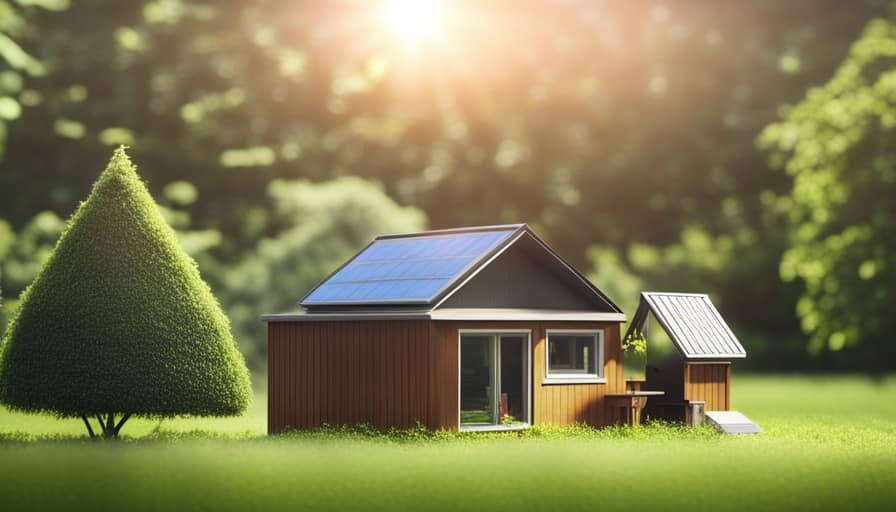
Utilizing Social Media and Online Communities
One can utilize social media and online communities to connect with fellow tiny house enthusiasts and discover potential listings for tiny houses for sale. Joining local groups on platforms like Facebook or Reddit can provide a wealth of information and resources. These groups often have members who are actively involved in the tiny house community and can offer valuable insights and recommendations. Engaging with these communities allows you to tap into a network of individuals who share your passion for tiny living and can guide you towards finding the perfect tiny house for sale.
Don’t hesitate to ask for recommendations within these groups, as members are usually more than willing to share their experiences and knowledge. By leveraging the power of social media and online communities, you can greatly increase your chances of finding the ideal tiny house for sale.
Now that we’ve explored the benefits of utilizing social media and online communities, let’s delve into the next step of the process – attending tiny house workshops and events.
Attending Tiny House Workshops and Events
To expand your knowledge and network in the world of tiny houses, consider attending workshops and events that focus on this unique lifestyle. These gatherings provide valuable opportunities to learn from experts, connect with like-minded individuals, and gain insight into the latest trends and innovations in the tiny house community. Here are three reasons why attending these workshops and events is beneficial:
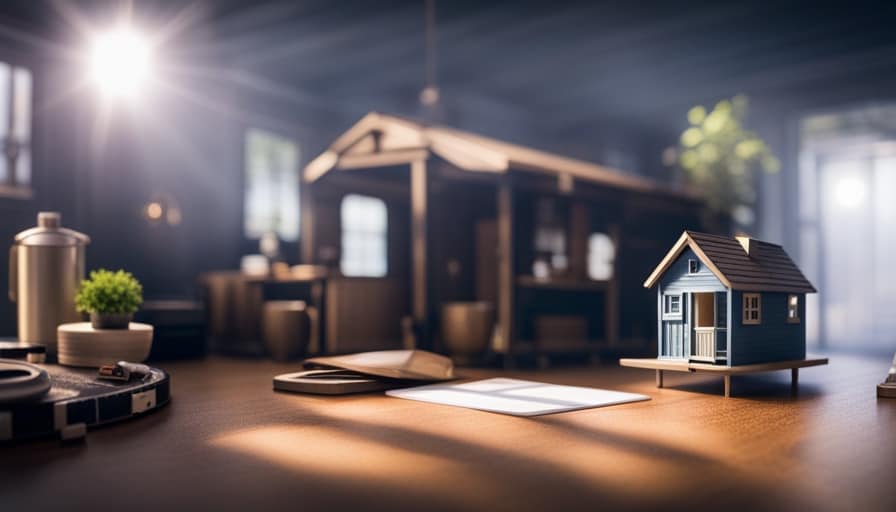
-
Education: Workshops and events offer a wealth of information on various topics, including tiny house financing options. You can learn about different financing methods, such as loans, grants, and crowdfunding, to help make your tiny house dream a reality.
-
Networking: Meeting fellow enthusiasts and professionals in the industry is a great way to expand your network. You can exchange ideas, share experiences, and potentially find partners or mentors who can guide you through the process of building a tiny house on a foundation.
-
Inspiration: By attending workshops and events, you’ll be exposed to a wide range of tiny house designs and styles. This exposure can inspire you to think creatively and find innovative solutions for your own tiny house project.
Considering Alternative Options for Tiny House Living
I’ve explored various tiny house options, but my favorite alternative is living in a converted shipping container. Not only are shipping containers affordable and readily available, but they also provide a unique and eco-friendly living space.

One of the best aspects of living in a converted shipping container is the opportunity to join tiny house communities. These communities are designed to foster a sense of connection and support among residents, creating a tight-knit community where everyone looks out for each other.
Additionally, renting options for converted shipping containers are becoming more popular, allowing individuals to experience the benefits of tiny house living without the commitment of purchasing a property. This flexibility is perfect for those who want to try out the lifestyle before fully committing.
Frequently Asked Questions
Are There Any Specific Regulations or Zoning Requirements for Placing a Tiny House on a Property?
Regulations and zoning requirements vary depending on the location. Before placing a tiny house on a property, it is important to research and comply with local laws. Consulting with a real estate professional can provide guidance in navigating these regulations.
What Are Some Common Challenges or Considerations When It Comes to Financing a Tiny House?
When it comes to financing a tiny house, there are several challenges to consider. Affordability is a major concern, as well as finding lenders who understand the unique nature of tiny homes.
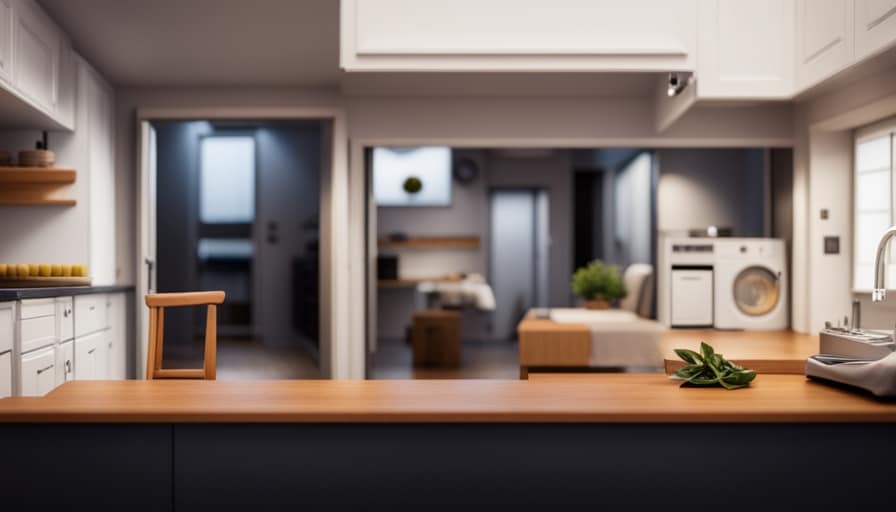
Can I Customize or Personalize a Pre-Built Tiny House From a Builder?
Yes, you can customize or personalize a pre-built tiny house from a builder. It allows you to tailor the design and features to your preferences, making it a unique and personalized space.
Are There Any Specific Insurance Considerations for Owning a Tiny House?
Insurance coverage for tiny houses requires considering their unique features and potential risks. It’s important to research insurance providers who specialize in tiny house coverage to ensure you have the right protection for your investment.
How Do I Navigate the Process of Finding Land or a Community to Park My Tiny House In?
Finding land or a community to park my tiny house in can be challenging. Research online platforms, local real estate agents, and tiny house communities. Visit potential locations, ask questions, and consider factors like zoning regulations and amenities.
Conclusion
In conclusion, there are several ways to make finding a tiny house for sale for adults easier. These include exploring online listings and websites, connecting with builders and companies, utilizing social media and online communities, and attending workshops and events.
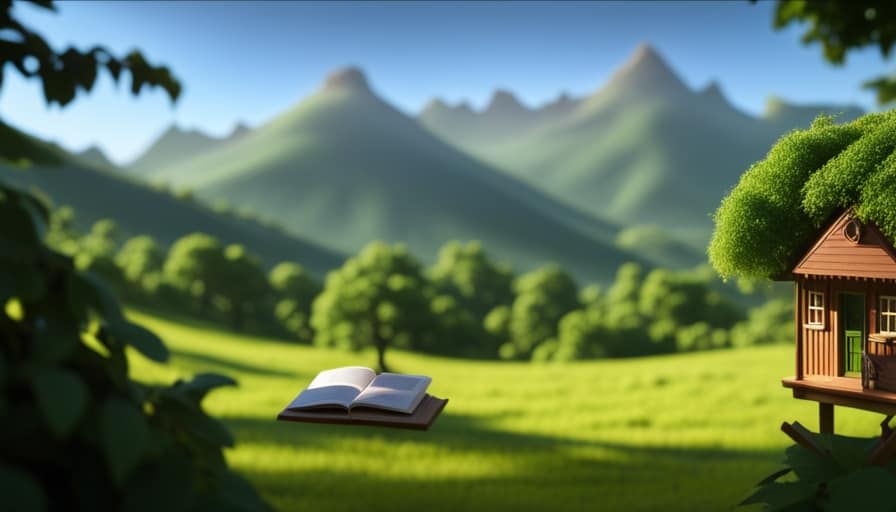
One effective method is to search for tiny houses for sale through online listings and websites. There are dedicated platforms that specialize in listing tiny houses, making it convenient to browse through various options and compare prices and features.
Another option is to connect directly with builders and companies that specialize in constructing and selling tiny houses. Many builders have websites where they showcase their designs and provide information on how to purchase or customize a tiny house according to specific needs and preferences.
Utilizing social media and online communities can also be helpful in finding a tiny house for sale. There are groups and pages dedicated to tiny house living where individuals can connect with others who are selling or buying tiny houses. These platforms provide a space for sharing information, asking questions, and even finding potential sellers or buyers.
Attending workshops and events related to tiny house living is another valuable way to find a tiny house for sale. These events often feature displays of different tiny house designs and provide an opportunity to meet builders, sellers, and other individuals who are passionate about tiny house living.

It’s interesting to note that the popularity of tiny house living is on the rise. According to a survey conducted by Tiny House Community, the number of adults opting for tiny house living has increased by 67% in the past five years. This statistic highlights the growing appeal and interest in this alternative lifestyle.
Overall, by utilizing online resources, connecting with builders and companies, engaging with social media and online communities, and attending workshops and events, adults can make the search for a tiny house for sale much easier.
I’m Theodore, and I love tiny houses. In fact, I’m the author of Tiny House 43, a book about tiny houses that are also tree houses. I think they’re magical places where imaginations can run wild and adventures are just waiting to happen.
While tree houses are often associated with childhood, they can be the perfect adult retreat. They offer a cozy space to relax and unwind, surrounded by nature. And since they’re typically built on stilts or raised platforms, they offer stunning views that traditional homes simply can’t match.
If you’re looking for a unique and romantic getaway, a tree house tiny house might just be the perfect option.
-

 Beginners Guides1 week ago
Beginners Guides1 week agoHow To Buy A Tesla Tiny House
-

 Energy Efficiency1 month ago
Energy Efficiency1 month agoBest Tiny Homes For Cold Climates
-

 Beginners Guides5 days ago
Beginners Guides5 days agoTiny House Nation Where Are They Now Stephanie
-

 Tiny House Resources (e.g., legalities, cost, insurance, FAQs)2 months ago
Tiny House Resources (e.g., legalities, cost, insurance, FAQs)2 months agoDo Tiny Homes Need Planning Permission?
-

 Beginners Guides2 weeks ago
Beginners Guides2 weeks agoFrom The Show Tiny House Nation How Many Keep Their Tiny House?
-

 Beginners Guides2 months ago
Beginners Guides2 months agoUsing a Climbing Net For Treehouse Construction
-

 Beginners Guides2 months ago
Beginners Guides2 months agoHow to Build a Treehouse Without Drilling Into the Tree
-

 Beginners Guides3 weeks ago
Beginners Guides3 weeks agoTiny House Nation Who Pays For The Houses







